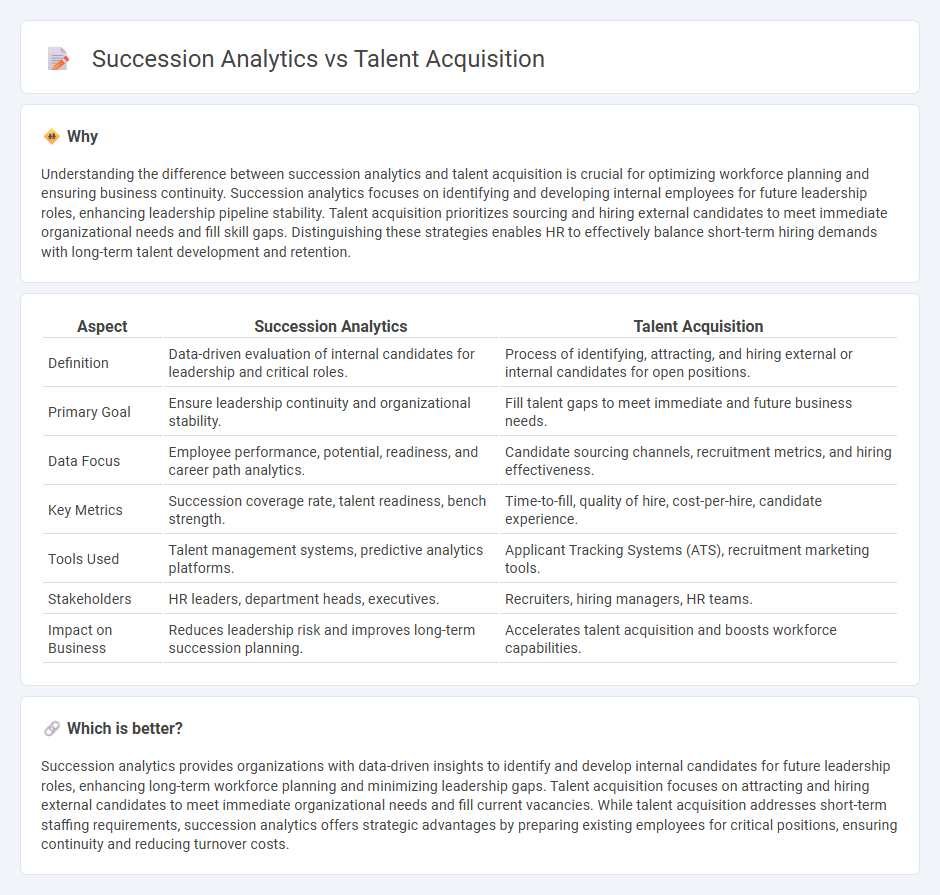
Succession analytics focuses on identifying and developing internal candidates for key leadership positions using data-driven insights, ensuring seamless organizational continuity. Talent acquisition emphasizes attracting and hiring external talent to meet immediate business needs and fill skill gaps. Explore the differences and strategic benefits of both approaches to strengthen your HR capabilities.
Why it is important
Understanding the difference between succession analytics and talent acquisition is crucial for optimizing workforce planning and ensuring business continuity. Succession analytics focuses on identifying and developing internal employees for future leadership roles, enhancing leadership pipeline stability. Talent acquisition prioritizes sourcing and hiring external candidates to meet immediate organizational needs and fill skill gaps. Distinguishing these strategies enables HR to effectively balance short-term hiring demands with long-term talent development and retention.
Comparison Table
| Aspect | Succession Analytics | Talent Acquisition |
|---|---|---|
| Definition | Data-driven evaluation of internal candidates for leadership and critical roles. | Process of identifying, attracting, and hiring external or internal candidates for open positions. |
| Primary Goal | Ensure leadership continuity and organizational stability. | Fill talent gaps to meet immediate and future business needs. |
| Data Focus | Employee performance, potential, readiness, and career path analytics. | Candidate sourcing channels, recruitment metrics, and hiring effectiveness. |
| Key Metrics | Succession coverage rate, talent readiness, bench strength. | Time-to-fill, quality of hire, cost-per-hire, candidate experience. |
| Tools Used | Talent management systems, predictive analytics platforms. | Applicant Tracking Systems (ATS), recruitment marketing tools. |
| Stakeholders | HR leaders, department heads, executives. | Recruiters, hiring managers, HR teams. |
| Impact on Business | Reduces leadership risk and improves long-term succession planning. | Accelerates talent acquisition and boosts workforce capabilities. |
Which is better?
Succession analytics provides organizations with data-driven insights to identify and develop internal candidates for future leadership roles, enhancing long-term workforce planning and minimizing leadership gaps. Talent acquisition focuses on attracting and hiring external candidates to meet immediate organizational needs and fill current vacancies. While talent acquisition addresses short-term staffing requirements, succession analytics offers strategic advantages by preparing existing employees for critical positions, ensuring continuity and reducing turnover costs.
Connection
Succession analytics leverages data to identify and develop internal candidates for key roles, enhancing the effectiveness of talent acquisition by targeting high-potential individuals aligned with organizational needs. Integrating predictive analytics with talent acquisition strategies enables HR teams to forecast future skill gaps and proactively source candidates, reducing time-to-fill and turnover rates. This connection ensures a continuous pipeline of qualified talent, supporting sustained business growth and leadership continuity.
Key Terms
**Talent Acquisition:**
Talent acquisition emphasizes identifying, attracting, and hiring top talent to meet current organizational needs through strategic sourcing, candidate engagement, and employer branding. Key metrics include time-to-fill, quality of hire, and candidate experience, helping companies optimize recruitment efficiency and effectiveness. Explore how advanced talent acquisition analytics can transform hiring outcomes and drive business success.
Sourcing
Talent acquisition analytics emphasizes sourcing strategies to identify and attract top candidates through data-driven insights, leveraging platforms like ATS and social media metrics to optimize recruitment pipelines. Succession analytics focuses on internal talent pools, evaluating employee readiness and potential to ensure leadership continuity and skill gap mitigation. Explore deeper strategies to enhance your organization's sourcing effectiveness in both domains.
Employer Branding
Talent acquisition leverages employer branding to attract top candidates by highlighting company culture, values, and career growth opportunities, significantly impacting recruitment success. Succession analytics focuses on evaluating internal talent readiness and leadership pipeline, using employer brand strength to retain high-potential employees and minimize turnover risks. Explore how integrating employer branding into both strategies enhances workforce stability and organizational growth.
Source and External Links
Talent Acquisition: The Ultimate Guide - AIHR - Talent acquisition is the process of identifying, attracting, selecting, and retaining highly qualified people using strategies like Build, Buy, Borrow, and Bridge to meet organizational goals.
What is Talent Acquisition? Tips & FAQs - SmartRecruiters - Talent acquisition involves identifying, acquiring, assessing, and hiring candidates, aligned with employer branding and collaboration with hiring managers to recruit and retain top talent.
What Is Talent Acquisition and How Does It Work? | Paycom Blog - Talent acquisition uses processes and strategies such as talent forecasting and pipelining to identify, hire, and retain employees that fulfill long-term business needs effectively.
 dowidth.com
dowidth.com